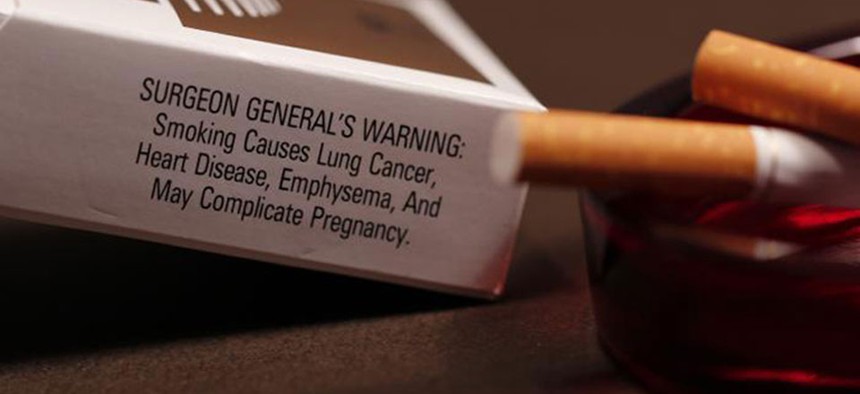
Debora Cartagena/CDC file photo
What Executives Can Learn From CDC's 'Winnable Battles' Strategy
Public health officials take on smoking and teen pregnancy, one performance goal at a time.
Everyone wants to jump to the top of the performance mountain. Citizens expect nothing less from their government. And every self-respecting public executive wants to improve performance not in incremental steps but by quantum leaps.
In reality, of course, no organization can jump to the top of the performance mountain. Just ask executives at the U.S. Public Health Service and Centers for Disease Control and Prevention. It’s now 50 years since Luther Terry, the 1964 U.S. surgeon general, released his famous report on smoking and health, now simply known as the “Surgeon General’s Report on Smoking.” That was when we first learned that smoking was bad for you.
Not really. Thirty-five years earlier, Hugh Cumming, the surgeon general then, said smoking was bad for women though not necessarily for men. Cumming, himself, smoked. So did many doctors and athletes, though coaches told their charges that smoking cut their wind.
Others, of course, asserted the opposite. In the 1930s, in a series of advertisements, famous athletes—including tennis star Bill Tilden and Lou Gehrig, the “Iron Horse” who played 2130 straight games at first base for the New York Yankees—proclaimed that “Camels don’t get your wind.” Other cigarettes may cut your wind. But not Camels.
Still, everyone knew. Their behavior, however, contradicted their knowledge. In 1965, a year after the “Surgeon General’s Report on Smoking,” annual adult consumption of cigarettes in the United States peaked at 4,259. That’s 12 cigarettes per day for every person over 18.
Since then, the trend has been down. By 2011, annual U.S. cigarette consumption had declined to 1,232 per adult—a drop of 70 percent in less than half a century.
Not bad. Then again, not great. It certainly had not gone to zero.
Moreover, in the previous decade, per-capita use of non-cigarette combustible tobacco (primarily pipes and cigars) more than doubled. Again, not great. Despite all the evidence about the evils of smoking—about the personal consequences of smoking—it has not gone to zero.
What is the CDC doing about this? Sensibly, it is not trying to jump to the top of this performance mountain (or, if you prefer a different metaphor, to dive to the bottom of this Mariana Trench). Yes, we would be all better off—even those of us who have never smoked—if cigarette consumption went to zero. After all, it would cut the costs of health insurance and reduce taxes for Medicare and Medicaid.
Still, the CDC does not pretend that it has the ability to cut cigarette consumption to zero in 2014. Or in 2015. Or in . . . CDC does, however, have 30 very specific performance targets for 2020. One of them is to reduce cigarette smoking by adults from 20.6 percent in 2008 to 12 percent. Another is to reduce the proportion of children aged 3 to 11 years exposed to secondhand smoke from the 2005-2008 baseline of 52.2 percent to 47 percent.
Wait, you might say: CDC’s target for little kiddies is to cut their exposure to secondhand smoke by only five percentage points? To just 47 percent? That’s still almost half of these kids.
Yes, you, I, and every CDC executive think the number of children exposed to secondhand smoke should be zero. The CDC leadership team cannot, however, afford to engage in Jiminy Cricket, when-you-wish-upon-a-star management.
The Centers for Disease Control has to be realistic. That’s why CDC executives have created a collection of 30 “winnable battles”—public health priorities for which CDC and other public-health professionals can achieve a measurable impact quickly.
CDC has also established several winnable Battles for food safety. One is to reduce the incidence of salmonella infections. From a 2006-2008 baseline of 15 cases per 100,000 population, CDC wants to cut the rate to 13 in 2015 and then to 11.4 by 2020.
Unfortunately, in 2010, the rate jumped to more than 17. And it hovered near 16 in 2011 and 2012. CDC and its collaborators will win this battle only with a lot of effort.
CDC also wants to cut the rate of births among adolescent females (ages 15 to 19). The baseline is the 37.9 births per 1000 females ages 15 to 19 in 2009. The 2015 target is a 20 percent reduction to 30.3.
This battle might be easier to win. After all, the rate was more than 40 in 2007 and has been declining steadily since then. Indeed, in recent years, it has been hovering near 30.
For each winnable battle, CDC has an overarching purpose, a set of specific targets, and a way to track and measure its progress.
It would be wonderful if anything that a public executive desired would indeed come true. Until then, all public executives need to define their own winnable battles.
Robert D. Behn, a lecturer at Harvard University's John F. Kennedy School of Government, chairs the executive education program Driving Government Performance: Leadership Strategies That Produce Results. His book The PerformanceStat Potential will be published by Brookings in 2014. Copyright 2014 Robert D. Behn.






